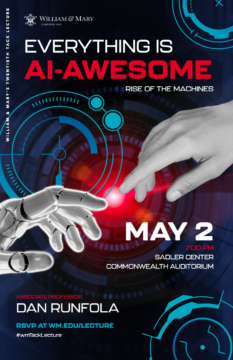Should we be frightened or excited by the rise of artificial intelligence? According to Dan Runfola, associate professor of applied science and data science at William & Mary, the answer is “both.”
Runfola will address the AI “revolution” in the spring 2023 Tack Faculty Lecture, “Everything Is AI-awesome: Rise of the Machines,” on May 2 at 7 p.m. in the Sadler Center’s Commonwealth Auditorium. The event is free and open to the public with a reception to follow, and attendees are asked to RSVP.
“At William & Mary, we have this wonderful nexus of individuals who care not only about the models, but also about how we are going to use these algorithms in practice,” said Runfola, whose research takes place at the intersection of deep learning and satellite imagery analysis.
Runfola compared the age of AI to the Industrial Revolution, with its potential to disrupt almost every job — including his own.
“The number of jobs at which humans are better than AI is going to go down, which leads us to a more fundamental question: How do we handle reallocation of wealth in a society where entire sectors that used to be dominated by human labor no longer require human attention?”
“Because research in this field is frequently in commercial settings, commercial applications have been a key driver of innovation,” explained Runfola, who is currently the principal investigator of the Geospatial Evaluation and Observation Lab. “Here at William & Mary, we’re seeing students consider implications well outside of commercial opportunities. Rather than asking ‘how do we make models more accurate,’ they are focusing on how to ensure that a particular modeling strategy will not result in some populations being left behind. This raises fundamentally different questions about data collection and modeling.”

The group of individuals controlling the creation of algorithms is also relatively small. As reported by Runfola, over the past 20 years much of AI research has happened within the private sector.
So, what comes next? Runfola is optimistic about a future in which AI can be a copilot for our everyday lives, taking on an increasingly broad spectrum of tasks.
“Today, with the right prompts you can ask a generative algorithm to write a poem; tomorrow, an AI might decide to read you a poem it wrote because you were looking glum,” said Runfola, with little doubt that such can be created in the near term. “That could be a beautiful thing. But — on the other side — if we don’t put safeguards, these same technologies could be used in detrimental ways: ‘I see you’re looking a little tired today, Dan – would you like me to order you a bottle of wine from our online store?’”
But is it all doom and gloom? Some may find it refreshing that Runfola also mentioned AI’s potential to do “incredibly helpful things for our society, making us happier and more productive.” His lecture promises to challenge the audience’s notions of AI and provide a glimpse (with live examples) into what the future will look like.
“It is up to us to determine whether the implications of these changes will lead to a more vibrant world, or to one in which power is consolidated in an exceptionally small number of hands,” concluded Runfola.
The Tack Faculty Lecture Series is made possible through a generous commitment by Martha ’78 and Carl Tack ’78. Initially launched in 2012, the Tacks’ commitment has created an endowment for the series of speakers from the W&M faculty.
Editor’s note: Data is one of four cornerstone initiatives in W&M’s Vision 2026 strategic plan. Visit the Vision 2026 website to learn more.
Antonella Di Marzio, Senior Research Writer

